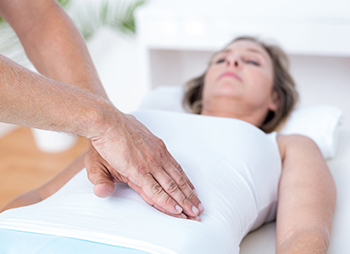Fibromyalgia and Osteopathy
 Fibromyalgia (or fibromyalgic syndrome) is a disease defined by the American College of Rheumatology as “a condition of widespread chronic pain, characterised by the presence of tender points during the physical examination”.
Fibromyalgia (or fibromyalgic syndrome) is a disease defined by the American College of Rheumatology as “a condition of widespread chronic pain, characterised by the presence of tender points during the physical examination”.
It occurs mainly in women, with a ratio of 3 to 1 compared to men, it can also occur in adolescents and younger children.
Although the exact cause of fibromyalgia is still unknown we do know physical and mental stress are present and that is often associated with fatigue and chronic fatigue.
In many cases, the condition appears to be triggered by a physically or emotionally stressful event, such as:
• an injury or infection
• giving birth
• having an operation
• the breakdown of a relationship
• the death of a loved one
The most characteristic symptom of fibromyalgia is the widespread chronic pain, referred to “the whole body”, present for at least 3 months. Some common expressions from the patients are: “I feel pain everywhere” or “it burns”, “I wake up tired, with no energy”.
The painful symptoms are aggravated by cold, by humidity, but also by stressful events, periods of inactivity or by functional overload.
Treatments
Although there’s currently no cure for fibromyalgia, there are treatments to help relieve some of the symptoms and make the condition easier to live with.
Depending on what your symptoms are, treatment could be a combination of:
• muscle relaxants used in the evening to promote sleep
• antidepressants
• anxiolytics
• anti-inflammatory drugs for the treatment of pain
• talking therapies – such as cognitive behavioural therapy (CBT) and counselling
• lifestyle changes – such as exercise programmes and relaxation techniques
Recently, new approaches such as manual therapy and osteopathy have been introduced.
Osteopaths deals with the health of the patient in its entirety and the use of osteopathic manipulative therapy in synergy with standard therapy allow for improving the symptomatology related to the disease.
 If Fibromyalgia benefited from manual therapy, there might be a possible rationale derived from the complex interaction of both physical and psychological patterns. When hands-on therapy is delivered to soft and connective tissues, local biochemical changes would be stimulated. This helps to improve muscle flexibility and modulate local blood and lymph circulation. As a result, local nociceptive and inflammatory mediators may be reabsorbed.
If Fibromyalgia benefited from manual therapy, there might be a possible rationale derived from the complex interaction of both physical and psychological patterns. When hands-on therapy is delivered to soft and connective tissues, local biochemical changes would be stimulated. This helps to improve muscle flexibility and modulate local blood and lymph circulation. As a result, local nociceptive and inflammatory mediators may be reabsorbed.
Some studies found that manual therapy improved pain by modulating serotonin levels in patients with Fibromyalgia. The local effects may change neural activity at the spinal cord segmental level, which is responsible for both mood and pain perception.
What to do next to get treatment for fibromyalgia
If you think you are suffering from any of the above conditions or anything else, please contact me in clinic at this link for advice and to book an appointment.
Biography:
Li YH, Wang FY, Feng CQ, Yang XF, Sun YH (2014). Massage therapy for fibromyalgia: a systematic review and meta-analysis of randomized controlled trials. PloS One. Feb 20; 9(2):e89304.
Yuan SL, Matsutani LA, Marques AP (2015). Effectiveness of different styles of massage therapy in fibromyalgia: a systematic review and meta-analysis. Man Ther. Apr; 20(2):257-64.


